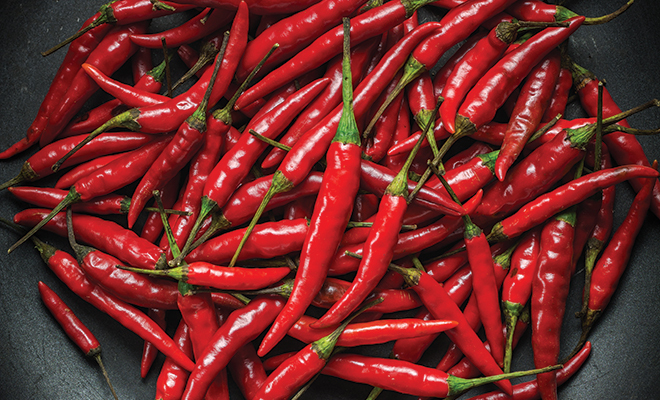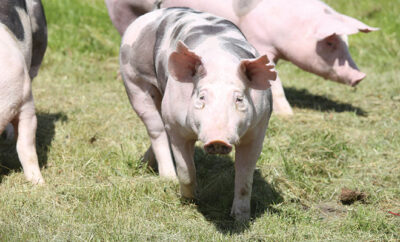
Some Like It Really Hot!
One basic healthy food habit is selecting fruits and vegetables in a rainbow of colors. Here’s a culinary riddle for you: can you name the fruit that most people consider a vegetable, but that’s also considered a spice? The food that serves this dual purpose is–peppers.
Grocery stores present an endless choice of peppers–fresh, dried, canned and pickled. Produce aisles display Anaheim, poblano, serrano and habanero peppers. Some peppers are specific to one region, such as the New Mexico Chile, or Hatch Chile, grown in the area around Hatch, New Mexico. Grocery stores celebrate the Hatch Chile harvest season by roasting them in a large cylindrical drum at the store entrance, where they are packed up to sell. The scent of roasting peppers wafting through the autumn air inspires customers to buy them while they’re still warm.
But home cooks are faced with a challenge; everyone has a unique definition of “spicy” when it comes to peppers. Your family meal may have conversations like this: “OH! This tastes really great, but it’s just too spicy for me.” “Really? You thought it was spicy? I thought it was just right.” “Well, I don’t think it’s hot at all; you should have added more.” My solution to this dilemma, whether I’m adding cayenne to mac and cheese, or jalapeño to salsa, or chile powder to a batch of chili, is to err on the side of caution. I use as much spice as needed for seasoning and flavor. The dish is served with additional peppers, sliced, roasted, pickled or bottled sauce, on the side.
Why do peppers have different levels of heat? Why isn’t there some objective way to rate the level of heat they have?
Peppers taste hot because of a compound they contain called capsaicin. When a recipe calls for wearing kitchen gloves while cleaning and chopping peppers, it’s to protect your skin from being irritated by capsaicin. If you clean hot peppers with your bare hands, you’ll quickly learn to avoid touching your face, especially your eyes, as this volatile compound will still be present on your hands.
A pharmacist from Detroit, Wilbur Scoville, developed a universal rating scale measuring the heat in peppers in 1912. His company used capsaicin for medicinal purposes in a muscle salve called Heet. The product could not be manufactured unless this ingredient was consistent. Scoville soaked peppers in alcohol, as capsaicin is alcohol soluble, then took a measured sample and diluted it with defined amounts of sugar water. Professional tasters would taste the samples, continuing to add units of sugar water until they could no longer perceive the “heat” of the pepper. Using this scale, a sweet bell pepper registers at 0 Scoville Heat Units, while jalapeños rank between 2,500 and 5,000, meaning between 2,000 and 5,000 dilutions of sugar water are required before the capsaicin is no longer detected. Cayenne is measured between 30,000 and 50,000 SHU. The capsaicin level in a typical canister of pepper spray is ranked at 2,000,000 SHU.
The Scoville method is still used as a rating scale, but it’s subjective. It relies on human taste buds, and the level of capsaicin in peppers can vary. Capsaicin is used in food products as well as medicines, which require a more reliable method. Thanks to HPLC, or high performance liquid chromatography, capsaicin is extracted from dried ground chiles using water, so the parts per million of capsaicin in water can be verified. This means you can trust processed food that is labeled mild, medium or hot. It also means that medicines with capsaicin, including capsules, creams and sprays to treat muscle and joint pain, both in people and animals, have reliably consistent doses.
You may think that peppers have existed in every continent and culture. After all, so many types of cuisine have signature dishes featuring peppers, including Hungarian hot paprika, spicy Indian food and fiery Szechuan and Thai dishes. In fact, peppers were not available worldwide until Christopher Columbus stumbled upon the New World. He encountered pepper plants and took them back to Spain. Merchants then introduced peppers to Europe, Africa, India and the Far East by the 16th century. Can you imagine a world that cooked without peppers until the past 400 years?
If your tolerance for hot peppers is boundless, try some of the hottest in the world. In 2007, the Naga Bhut Joloki, or Ghost chile, was said to be the hottest ever. In 2010, the Naga Viper claimed first place. In 2012, the Trinidad Moruga Scorpio was first, rating 2 million SHU, the same as pepper spray! Today, the Carolina Reaper is in first place. This pepper, a cross between a Naga and Red Habanero, boasts 2.2 million SHU. It’s said to have excellent flavor–if you can stand the heat. ■
Sources: cayennediane.com, pepperscale.com and pepperheadsforlife.com.







